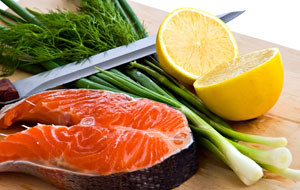Going fishing for better heart health is easy when you consume certain types of seafood that are high in omega-3 fatty acids. Omega-3 fatty acids include fish oil, and fish oil contains eicosapentaenoic acid (EPA) and docosahexaenoic acid (DHA). EPA and DHA studies have shown that the intake of recommended amounts of each of these acids via dietary fish lowers blood pressure slightly, lowers triglycerides, reduces the risk of abnormal heart rhythms, reduces the risk of heart attack, and reduces the risk of strokes in people with known cardiovascular disease, and slows hardening of the arteries. It’s important to note, though, that high doses of EPA and DHA may have harmful effects.
One study on fish and heart health found that women who ate five or more servings of baked or broiled fish per week had a 30 percent lower risk of developing heart failure, and the study also found that eating dark fish—bluefish, mackerel and salmon—was tied to a 22 percent lower risk of heart failure.
The American Heart Association recommends eating fish at least two times per week and baking or grilling fish, not frying. Fish that are high in EPA and DHA include: lake trout, herring, mackerel and salmon.

